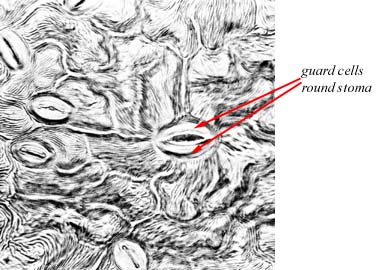 |
 |
TS section through lower epidermis |
surface view of leaf epidermis |
| As
transpiration takes place, water diffusing into the air
spaces from the spongy mesophyll cells takes its place.
This is turn sets up a concentration gradient across
which water moves by osmosis out of the xylem cells and
across the leaf. A similar concentration gradient occurs
between the xylem and palisade layer so that water will
also move by osmosis to the palisade cells in order that
it can be used by these cells in the food manufacturing
process of photosynthesis. In most plants about 98% of the water taken in by the roots is transpired from the leaves' surfaces. To give some idea of the magnitude of water movement, it has been calculated that during the day a 15 metre high Silver Maple (Acer saccharinum) can lose up to 220 litres of water per hour through transpiration. |
|